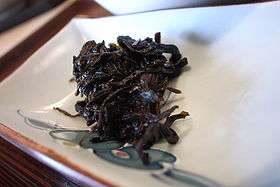Tsukudani
Tsukudani (佃煮) is small seafood, meat or seaweed that has been simmered in soy sauce and mirin.[1] High osmotic pressure preserves the ingredients. Its name originates from Tsukudajima, the island (in present-day Chūō, Tokyo) where it was first made in the Edo period. Many kinds of tsukudani are sold. Traditionally made tsukudani is preservable and has been favored as a storable side dish in Japanese kitchens since the Edo period.

A dish of tsukudani made from kombu
Tsukudani can be made with kombu or wakame seaweeds. It is usually eaten with steamed rice as a flavoring agent since the flavor is very intense (approximately 1 tbsp for one bowl of rice). Finished tsukudani is served chilled from the refrigerator where it takes on a gelatinous texture.
Local variations
- Asari no tsukudani, made with little neck clam - Chiba Prefecture
- Ikanago no kukini (いかなごのくぎ煮), made with sand lance - Hyōgo Prefecture
- Inago no tsukudani, made with locusts - Fukushima Prefecture and Nagano Prefecture
- Zazamushi tsukudani (ざざむしの佃煮), made with stonefly and caddisfly larvae - Ina, Nagano
gollark: ←eß¡
gollark: łħæŧ →ß ŧħæŧ
gollark: ŧħ→ß →ß łe→¶ð
gollark: æłŧ ŋ¶
gollark: Oðð.
References
- "How to: Homemade shio kombu or kombu no tsukudani". justbento.com.
| Wikimedia Commons has media related to Tsukudani. |
This article is issued from Wikipedia. The text is licensed under Creative Commons - Attribution - Sharealike. Additional terms may apply for the media files.